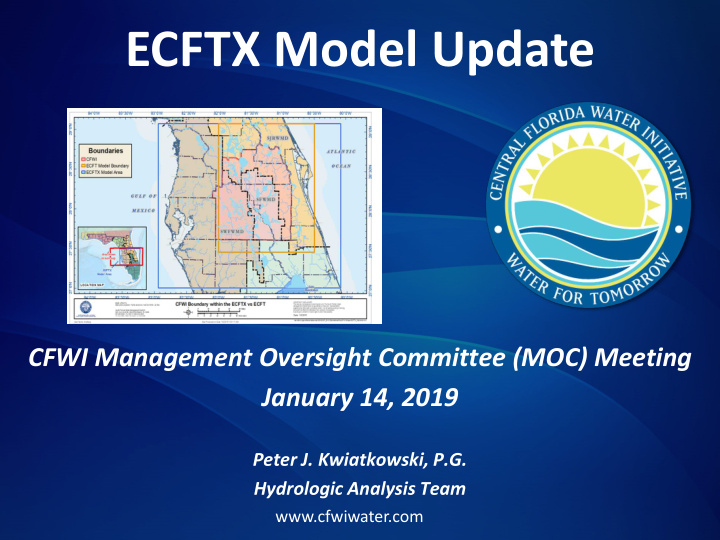



ECFTX Model Update CFWI Management Oversight Committee (MOC) Meeting January 14, 2019 Peter J. Kwiatkowski, P.G. Hydrologic Analysis Team www.cfwiwater.com
Objectives Improve confidence in model and associated predictions by: – Reducing boundary issues – Becoming more computationally efficient – Resolving water use discrepancies – Reaching consensus on hydrostratigraphy and model layering – Incorporating more recent data for calibration (2004 to 2012) and verification (2013 to 2014)
Boundary Locations ECFT – 10,000 sq. mi ECFTX – 25,000 sq. mi
Model Improveme nts – Incorporate additional model layering of the Lower Floridan Aquifer – Use of information from other peer- reviewed models – Improved conceptualization of boundary conditions – Atlantic Ocean and Gulf – Peer Review – incorporate comments as we go – Consistency between the model and reported use described in the water supply plan using a single water use database Figure 1. Critical Hydrogeologic Units
Peer Review Panel – Groundwater Modeling Experts • Louis Motz, PhD, Associate Professor Emeritus, University of Florida • Mark Stewart, PhD, Professor Emeritus, University of South Florida • Peter Anderson, P.E., M.S., Principal Engineer, Tetra Tech GEO – Scope of Work – Review: • Conceptual Model Documentation • Calibration Plan and Implementation • Final Documentation
Timeline – Started Work – March 2015 – Peer Review Kickoff – September 2016 – Steady-State Calibration – June 2018 – Transient Calibration – November 2018
Plan Forward – Peer Review Concurrence with Calibration – January 2019 – Complete Normalization (De-trending) of Water Use Demands – January 2019 – Conduct Reference Condition Simulation – January 2019 – Conduct 2030 and 2040 Simulations – February 2019 – Prepare DRAFT Model Documentation – March 2019 – Peer Review of Model Documentation – May 2019 – Final Model Documentation – July 2019
Questions?
Recommend
More recommend